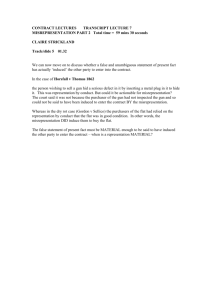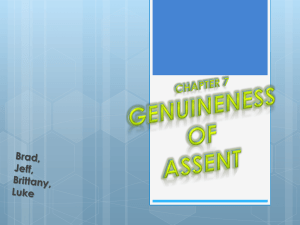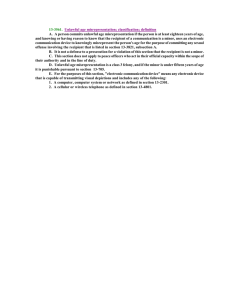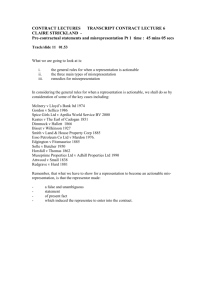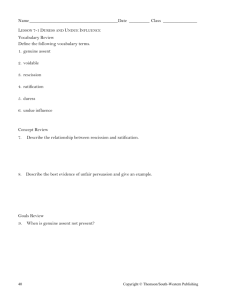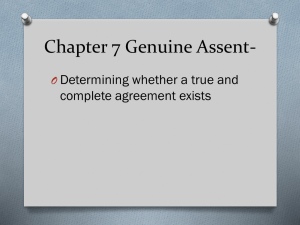Contract Law 7 PowerPoint
advertisement
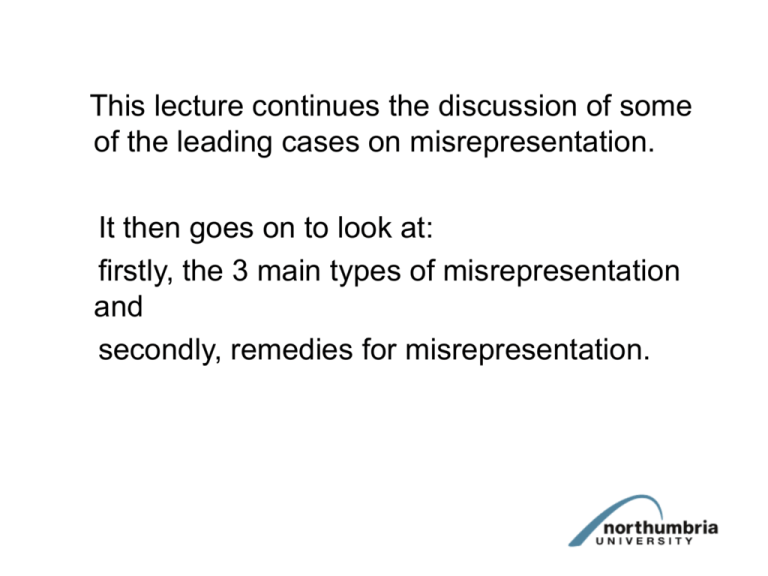
This lecture continues the discussion of some of the leading cases on misrepresentation. It then goes on to look at: firstly, the 3 main types of misrepresentation and secondly, remedies for misrepresentation. Smith v Land & House Property Corporation 1885 Esso Petroleum Co Ltd v Mardon 1976 Edgington v Fitzmaurice 1885 Lord Denning MR stated that: ‘… it was a forecast made by a party …Esso…who had special knowledge and skill… They were in a much better position than Mr Mardon to make a forecast…If the forecast turned out to be an unsound forecast such as no person of skill or experience should have made, there is a breach of warranty…It is very different from the New Zealand case (Bisset v Wilkinson) where the land had never been used as a sheep farm and both parties were equally able to form an opinion as to its carrying capacity.’ Solle v Butcher 1950 If someone makes a statement of law that is not abstract but directed towards a particular set of facts, then it may be actionable as a misrepresentation due to the part of the statement that relates to facts. Horsfall v Thomas 1862 The person wishing to sell a gun hid a serious defect in it by inserting a metal plug in it to hide it. This was representation by conduct. But could it be actionable for misrepresentation? The court said it was not because the purchaser of the gun had not inspected the gun and so could not be said to have been induced to enter the contract BY the misrepresentation. Museprime Properties Ltd v Adhill Properties Ltd 1990 ‘A representation is material if it is something that induces the person to whom it is made, whether solely or in conjunction with other inducements, to contract on the terms on which he does contract.’ Attwood v Small 1838 The House of Lords held that there was no misrepresentation since the purchaser had relied on his own experts and not on that of the seller, thus they were NOT INDUCED to enter the contract by the valuation given by the seller. Redgrave v Hurd 1881 The trial judge had said that either Hurd did not rely on the statement about the extra £100 or that if he did rely on it then his own negligence in looking at the papers only fleetingly lost him his cause of action. Jessel MR said that this point about negligence was a totally wrong opinion not correct in law. The types of misrepresentation Before 1964 there were 2 types of misrepresentation, both common law types, that is: - Fraudulent misrepresentation, and - Innocent misrepresentation. ] After 1964 two more types were added, that is: - At common law – negligent misstatement, and - In statutory form – negligent misrepresentation under s 2(1) Misrepresentation Act 1967 Fraudulent misrepresentation In Derry v Peek 1889 in the House of Lords, Lord Herschell stated that fraudulent misrepresentation required proof that: a false representation had been made - knowingly - without belief in its truth - or recklessly or carelessly as to whether it was true or not Innocent misrepresentation Where the misrepresentor had made an innocent statement of false fact, then although the misrepresentee may take him to court, the usual remedy for innocent misrepresentation is rescission of the contract, that is, setting it aside. The misrepresentee has no right to damages as such, but, the court may award damages in its discretion under the Misrepresentation Act 1967. Negligent Misrepresentation This is really an action in negligence, so does NOT need a contract to exist to be used. It was established in the case of Hedley Byrne v Heller 1964. If there is a contract between the parties, then it is usual to use s 2(1) Misrepresentation under the Misrepresentation Act 1967. Negligent misrepresentation under section 2 (1) of the Misrepresentation Act 1967 ‘Where a person has entered into a contract after a misrepresentation has been made to him by another party thereto, and as a result thereof he has suffered loss, then [if the person making the misrepresentation would be liable to damages in respect thereof had the misrepresentation been made fraudulently, that person shall be so liable notwithstanding that the misrepresentation was not made fraudulently] unless he proves that he had reasonable ground to believe and did believe up to the time the contract was made that the facts represented were true’. Remedies for misrepresentation The remedies available for a misrepresentation are: rescission damages, and indemnity and we will look at each in turn. Rescission When the misrepresentee discovers the misrepresentation, they have a choice – they can either: • AFFIRM the contract despite the misrepresentation or • they can RESCIND the contract. Once this decision has been made it cannot be changed. Rescission may not be possible where: • the misrepresentee has ‘affirmed’ the contract • the parties cannot be restored to their precontractual positions • when the subject matter of the contract has been sold on to an innocent third party before rescission was communicated to the misrepresentor • due to lapse of time • if refused by the court under section 2 (2) of the Misrepresentation Act 1967 Redgrave v Hurd 1881 Although Redgrave had won at first instance and the court had ordered specific performance by Hurd, in the Court of Appeal, Hurd was allowed to RESCIND the contract and get the return of his deposit. Damages Damages are only available AS OF RIGHT for fraudulent and negligent misrepresentation. Damages are not available as of right for ‘innocent’ misrepresentation, BUT they may be awarded at the discretion of the court under the Misrepresentation Act 1967 section 2(2) when the court refuses rescission. Damages for Fraudulent Misrepresentation Damages here are based on the Tort action of Deceit such that the defendant must pay for: all the ‘losses that flow directly from the contract’ even if the loss was not foreseeable. This was established in the case of Doyle v Olby (Ironmongers) Ltd 1969. This rule has been confirmed in later cases and the leading case now is Smith New Court Securities Ltd v Citibank NA 1997. Damages for Negligent Misrepresentation First, at common law At common law damages are based on the Tort of Negligence and so only those damages that are ‘foreseeable’ can be recovered. Secondly, under s 2(1) Misrepresentation Act 1967 In Royscott Trust Ltd v Rogerson 1991 it was held that damages under s 2(1) for negligent misrepresentation were to be calculated on the SAME basis as FRAUDULENT misrepresentation. Damages for Innocent Misrepresentation Damages are not generally available for innocent misrepresentation since rescission is the main remedy, but they may be awarded at the discretion of the court under s 2(2) when rescission is not ordered. Indemnity • This remedy is available whenever rescission is available. Its worth is most apparent in relation to innocent misrepresentation. Since damages are not available as of right for innocent misrepresentation, a claimant may seek an indemnity in addition to rescission to cover expenses incurred by them which are the result of entering into the contract. • This can be seen in the case of Whittington v Seale-Hayne 1900.

